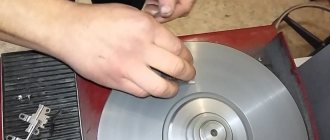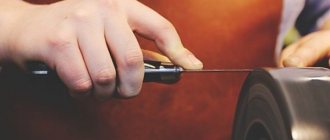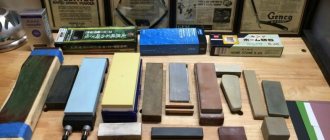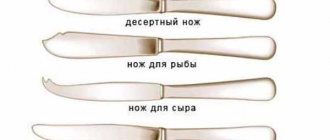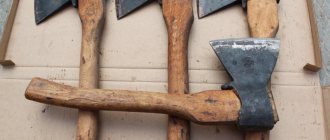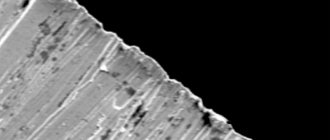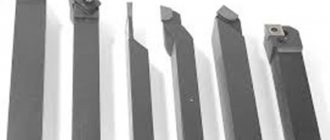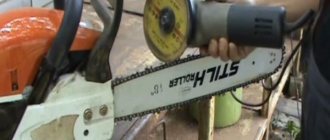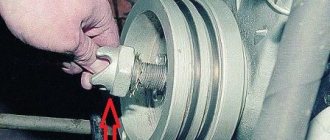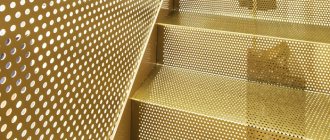How to prepare scissors for sharpening
Before you start sharpening, check whether the performance of the blades is actually affected by dullness. Sometimes scissors may not cut well due to the loosening of the connecting element. It could be a bolt or rivet.
After fixing all the problems, cut something and thereby check whether sharpening is needed. If the blades do not cut well, you will need to sharpen them. Before use, wipe the knives with a cotton swab and an alcohol solution. Remove more stubborn stains using suitable chemicals.
CARE AND STORAGE OF PRUNERS
The main thing in caring for the tool is to clean the blades from thickened juice and dirt after finishing work. After pruning branches affected by pests, which is typical for old currant bushes, it is recommended to dip the pruning shear blades in a solution of potassium permanganate for a while, then wipe them dry and lubricate them with machine oil. Some secateurs have special inserts in the handles with a piece of felt, which is impregnated with oil for this purpose.
TOOLS FOR HOME AND GARDEN, HANDCRAFTS, ETC. PRICES VERY LOW
Self-sharpening methods at home
There are many ways to sharpen scissor blades at home. To do this, you can use improvised materials that are found in almost every apartment.
Needle or awl
To sharpen you will need a thick needle or awl. The method is quite energy-intensive, so it is suitable for processing small scissors.
Cut the selected item from the rings to the tips of the blades. Try to guide the needle along the sharp edges. Your actions should not be performed through force.
Metal sponge
You can use either new or used metal sponge. The softer the sponge, the better.
Cut the sponge with scissors, using the entire surface of the blades. The more cuts you make, the sharper the blades will be. Please note that during the procedure the sponge crumbles a lot, so it is better to cut directly above the trash can.
Glass jar or bottle
In this procedure, it is best to use an unnecessary jar, since after sharpening there will be scratches on the glass.
- Take the jar in your hand and make the required number of cutting movements. During sharpening, the entire surface of the blades should touch the glass.
- After work, carefully remove small glass fragments from the surface of the blades.
- If you need to sharpen small scissors, use a glass bottle with a narrow neck.
Foil
Take a sheet of foil and fold it into 6-8 layers. You should get a fairly dense layer. Cut the foil into small strips, using the entire surface of the blades. The duller the knives, the more cuts you need to make.
Special sharpeners
A special sharpener can be purchased at a hardware or construction department or ordered from an online store.
Open the scissors and slide each blade through the designated hole. Do the required number of passes until the blades become sharp.
Sandpaper
Like other available materials, scissors are sharpened with sandpaper by cutting it. First, fold the paper in half with the rough side facing out and cut into small strips.
The finer the sandpaper grains, the better. The ideal option would be zero-grit sandpaper.
File
Open the scissors to their maximum width and hold with your hand where the blades meet. This will allow each half to hold tightly and not become loose during the procedure.
File the inside of each blade at a 70 to 80 degree angle. Make movements either only from yourself, or only towards yourself. Never saw the blades by jerking back and forth. Just a few movements are enough to sharpen.
If you cannot hold the scissors tightly with your hand, use a vice.
Grindstone
A similar stone can be purchased at a hardware store or hardware store. Before sharpening, separate the scissors into their component parts by unscrewing the central screw. Apply each blade in turn to the stone with its sharp side and make several movements towards or away from you until the desired sharpness is achieved. At the end of the procedure, assemble the halves by connecting them with a central screw.
Grinder
To use a sharpening machine, sufficient experience and dexterity is required.
The machine is a device with a rotating abrasive wheel. Simply turn on the device and place the halves on the sharpening disc.
In the procedure, it is extremely important to know what angle must be maintained between the blade and the wheel, as well as how long to sharpen, so if you are not familiar with the device, give preference to another method.
Paper clip
Please note that the larger the paperclip, the better.
Hold the paper clip tightly with the tips of the blades and slowly, squeezing the scissors with your fingers, draw it to the base. Repeat the procedure until the scissors are sharp enough. You'll know the scissors are sharpening when you notice small nicks in the paper clip.
Battery
In a similar way to a paper clip, you can sharpen scissors using an unnecessary AA battery. Please note that the battery must be in a metal casing. Clamp the battery with the blades and move it to the base the required number of times.
Screwdriver
Since the paperclip or battery is quite small, it can be replaced with a screwdriver to sharpen larger scissors. Place the screwdriver, metal side down, on a hard surface. Pinch it with the tips of the blades and slowly move it to the base. Repeat as many times as needed to keep the blades sharp.
Where can you sharpen scissors?
Typically, this service is provided in key-making or shoe repair shops. The cost of sharpening scissors is from 50 rubles, depending on the complexity of the service.
WHAT TO USE TO SHARPEN GARDEN SHEARS
Whenever I talk about this topic, one of the first questions I get asked is, “What tool do you use to sharpen your garden shears?”
The good news is that you have several options to choose from. Heck, you may already have a sharpening tool on hand that will do the job just fine. Here are a few of the most common...
- The garden tool sharpener is my favorite tool, specifically designed for sharpening garden shears and loppers. I highly recommend this one, especially for beginners.
- Scissors for sharpening tools - If you already have a tool for sharpening scissors, then you can use that on your scissors too. No need to buy another one.
- Diamond File – Some people prefer to use a simple diamond file. So, if you have experience using it, it is also great for sharpening garden tools.
- Whetstone – The blades of pruning shears can be sharpened just like a knife with a whetstone.
Different types of sharpeners for garden tools
Subtleties of the sharpening process
Depending on the type and purpose of the scissors, sharpening may have some subtleties and nuances.
Regular
Scissors that cut paper or other materials can be sharpened at home, spending very little time. Use foil, sandpaper, or another metal-coated object to sand the blades.
Kitchen
At home, it is best to sharpen kitchen scissors in a way that does not require disassembling them. Foil, sandpaper or metal sponge work well. However, such sharpening will not provide long-term results. For better processing, contact professionals.
Manicure
High-quality manicure scissors are quite difficult to sharpen at home. To do this, you need to know how to properly tighten the connecting element and what the sharpening angle should be. The blades are processed with a special diamond needle file from base to tip.
Hairdressers
Hair cutting scissors are made from high-quality materials, as they are designed for a long service life. Properly sharpening blades at home is very difficult and risky. Entrust sharpening to a professional who uses special laser equipment for the job.
Thinning
Thinning scissors have a special structure. They consist of double blades - serrated and straight. It is impossible to sharpen such an item at home, since the work requires certain equipment and knowledge.
Tailor's
It is extremely important when sharpening fabric scissors not to leave jagged edges on the blades, so use smoother materials for processing, such as foil or zero-grade sandpaper. After sharpening, be sure to check the quality of the cut on an unnecessary piece of fabric.
If these are zigzag scissors for processing the edges of fabric, then they can only be sharpened in a workshop.
Garden
For sharpening, you can use a whetstone or a machine. Disassemble the scissors into their component parts and sharpen them accordingly.
Metal scissors
To process metal scissors, be sure to maintain a sharpening angle of approximately 75 degrees. In preparation, separate the blades by unscrewing the connecting bolt. You can sharpen knives with a file or sandpaper. After the procedure, treat the parts with an anti-corrosion agent to extend their service life.
Sheep
Such scissors require maximum sharpness, so processing with foil or sandpaper will not work. Blades must be sharpened using a machine with an abrasive wheel. Process each blade separately, opening the halves as wide as possible.
Non-separable
Scissors cannot be disassembled without a connecting bolt. For sharpening, choose simple methods that do not require separating the halves, such as using a needle, foil or sandpaper.
How to sharpen secateurs
These shears have one curved blade and one straight blade and are designed to cut tree branches larger than an inch in diameter. It will be necessary to damage the hedge shears when using them to trim trees. Disassemble the scoring shears for sharpening.
Step 1 – You need to prepare a curved knife for trimming
You must use a socket wrench to unscrew the pivot nut and separate the trimming shears from each other. You also need to place the bottom of the curved blade into the vice handle with the tip facing up and secure it tightly with the rotating handle. Afterwards, you need to clean the blade and wipe off any debris and rust.
Step 2 - Sharpen the curved blade
Short, firm strokes must be used to bring the blade bevel close to sharp from the tip of the file to its midpoint. Afterwards, you need to release it from the vice, wipe it and lubricate it with light oil on a soft cloth.
What not to do when sharpening scissors
To avoid ruining the sharpness of the blades:
- Do not try to sharpen non-standard scissors (hairdressing scissors, thinning scissors, manicure scissors) yourself. Their sharpening requires the use of professional equipment.
- Maintain the sharpening angle corresponding to the factory one. If handled incorrectly, the blades will become unusable.
- Do not disassemble the scissors if you are not sure that you can put them back together.
General recommendations
For long-term service of the pruning shears, it is necessary to regularly care for it and monitor the condition of the blades. Before the winter season, it is recommended to lubricate the tool with grease. The pruning shears are left for storage wrapped in oiled cloth.
How often to sharpen depends on the frequency of use of the tool. If it is used for more than four hours every week, then the procedure is carried out at least three times per season. It is recommended to monitor the quality of the pruning shears. If he starts chewing branches, then it's time to sharpen him.
The procedure is quite simple. You can easily do it with your own hands. The main thing is that the tool is made of good steel and plastic. Low-quality models may not withstand sharpening and become unusable.
Subscribe to our Social networks
Why don't scissors cut?
It happens that the blades retain their former sharpness, but the scissors still do not cut. In such cases, you need to check for a gap between the knives and also see if the cutting edge is broken.
How does a gap occur?
Due to increased loads, over time, the connection of the halves weakens slightly and a gap appears between the blades. Sometimes it happens that the metal of the knives becomes slightly deformed. To ensure that the scissors cut well again, adjust the mount or align the blades.
Cutting edge irregularities
Over time, the metal of the blades wears out and becomes deformed. To level the cutting edge, you should contact a professional craftsman who will sharpen and polish the surface of the edge.
How to adjust blade stroke
To adjust the fastener that affects the gap:
- If it is a bolt, carefully tighten it using a small screwdriver. Be careful not to over-tighten; if you tighten too much, the halves won't be able to move.
- If the connection is a rivet, open the scissors and place it on a metal surface. Then use a few blows of a hammer to flatten the plug.
- If there is a stop at the junction of the halves, open the scissors and carefully sharpen it.
CORRECT SHARPENING OF SCISSORS AND SECATORS - PHOTO
1. Lawn shears and hedge trimmers are best sharpened using a miter gauge that provides the required sharpening angle.
2.Finely sharpened blades should be sharpened on a leather belt or grinding wheel.
3. Apply finishing paste to a leather-covered grinding wheel, which picks up metal particles formed when removing burrs, thereby increasing the efficiency of finishing.
4.When sharpening, the scissors are disassembled; this is not necessary for finishing. Most models of scissors have threaded connections.
5.When finishing, first process the sharpened side of the blade, making movements with the whetstone in the direction of the arrow.
6.The back side of the blade is finished by lightly rubbing it with a whetstone. If, due to accidental contact with wire or nails, nicks have formed on the cutting edge, they must be removed.
8. The scissors are disassembled into parts, which are thoroughly cleaned of dirt.
Read also: Attachment for a sharpening machine for sharpening knives
9.First, process the blade on the rough side of the whetstone, removing nicks. The blade is held at right angles to the whetstone.
10. Having removed the notches, the blade is processed with a cutting edge on the fine-grained side of the whetstone and the back side of the blade is finished, running it flat over the whetstone.
11.After inserting the blade, lubricate the mechanical parts of the scissors.
12. Having assembled the scissors or pruning shears, tighten the fixing nut so that the scissors work easily.
How to keep scissors sharp at home
To keep your blades sharp for as long as possible, follow these simple rules for using them:
- Do not use boiling to disinfect. It is better to wipe the blades with an antiseptic.
- Treat the mechanism for connecting the halves with any oil once every 6 months.
- Use scissors only to cut materials that are suitable for their intended purpose.
Always wipe the blades with a piece of cloth after use. Store scissors in a special case and do not allow liquids to come into contact with the knives.
How to remove rust from scissors
If the metal is covered with rust, it can be removed using special or improvised means. Special substances easily cope with plaque and do not spoil the metal. However, such funds are not always available at hand, and they are quite expensive.
An alternative to store bought substances can be substances that are available in almost every apartment. You can remove rust with:
- slurry of water and soda;
- solution of citric acid or vinegar;
- peeled potatoes.
If the rust has not yet become deeply ingrained into the metal, the blades can be cleaned with sandpaper or a metal sponge.
Scissors are a simple item that requires simple operating rules. Some types of them require special sharpening only in professional workshops. To process regular blades, you can use materials that are always on hand. At the same time, the procedure does not require any special skills from you, and also will not take much effort and time.
HOW TO SHARPEN PRUNERS
The good news is that pruning shears are very easy to sharpen and will soon be working (and looking) like new again.
Plus, you don't need a lot of supplies to get the job done. You probably already have most of this home.
NECESSARY MATERIALS
- Sharpening tool (I use a garden tool sharpener or a scissor sharpener)
- Something to test your cuts (such as plant stems or leaves)
- Liquid soap
- Cleaning cloths (dry and wet)
- Cleaning brush (optional)
- Wire brush (optional)
- Steel wool (optional)
- Lubricating oil (mineral oil, linseed oil, 3-in-1, WD-40, etc.)
- Goo Gone or orange essential oil (optional)
Consumables needed to sharpen garden shears
CLEAN THE PRUNERS.
Before sharpening your pruners, it is recommended that you clean them to remove any residue that has accumulated over time. This will remove any obstructions that might interfere with sharpening the blade.
You can simply wipe them with a damp cloth if they are not very dirty. But if yours are as neglected as mine, follow these steps to clean them up.
Step 1: Wash your pruners. Wash your pruners with soap and water to remove any dirt, then wipe them with a damp cloth.
When finished, rinse them with water, but do not soak them. This can do more harm than good and speed up the rusting of the metal.
My hand pruner with soap
Step 2: Rub them if necessary. If the dirt is stuck and the dirt doesn't come off easily, use a cleaning brush to scrub it off.
If necessary, apply orange essential oil or a product like Goo Gone to the blade to remove any dirt and sticky juice.
While you're at it, be sure to clean the handles and other parts rather than focusing just on the blade. You might as well spend a few extra minutes to get them looking brand new again.
Removing dirt from pruning blades
REMOVE RUST FROM THE BLADE.
Sometimes rust can form on the blades of pruning shears. This can cause them to stick together, making them difficult to use.
So, if any of your pruning tools are like my hedge trimmers, follow these steps to remove rust from the blade. Otherwise, skip to Section 3: Sharpening Pruners below.
Rust on my hedge trimmer blade
Step 3: Use a wire brush to remove heavy rust stains - First, remove thick rust stains with a wire brush. You will also need to use it to remove rust around the edges and in any crevices.
Removing rust from a blade with a wire brush
Step 4: Remove rust from the blades using steel wool. You can now clean the blade with steel wool to remove any remaining rust.
Removing rust from a blade with steel wool
It only takes a few minutes to get all the blades sparkling and looking brand new (plus it's a really good triceps workout, bonus!).
With a little elbow grease, your garden shears will look like new and be ready to sharpen. Amazing!
Hedge trimmers ready for sharpening
SHARPEN THE PRUNERS.
Once you've cleaned your garden shears and removed any rust, it's time to sharpen the blades.
You can follow these steps to sharpen any type of pruner. Whether you have large or small hand pruners, precision shears, hedge trimmers or loppers.
Step 5: Find the right angle - Hold the sharpening tool against the blade at the same angle of the existing bevel (usually around 20-25 degrees).
If you've never sharpened a pruning shear before, it may take some practice to get the blade angle right.
Step 6: Sharpening the Blade - Moving from the base to the tip, scrape the sharpener along the length of the blade in one smooth motion, pressing firmly.
Repeat the same action 10-20 times (for extra dull blades, 25-30 strokes may be required).
Many types of pruning shears are sharp on only one side of the blade, while the other side is flat. If this is your case, you only need to sharpen the blade and leave the flat side alone.
Sharpening the pruner blade
Step 7: Checking the Sharpness - Check the sharpness of the blade on some leaves or branches after each series of strokes. Once you get a clean and easy cut, you'll know you're done.
Checking the sharpness of garden shears
